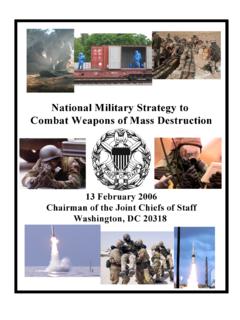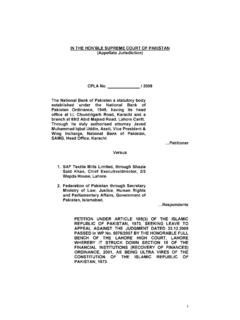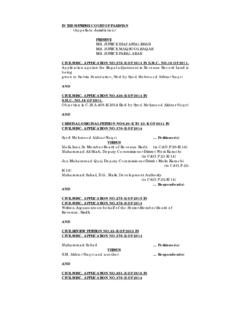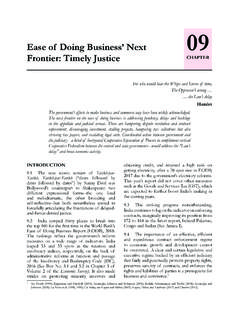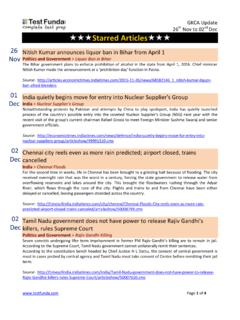Transcription of Timeline of U.S. Pakistan Relations - acsc …
1 Page 1 of 10 Timeline of Pakistan Relations From the Council on Foreign Relations ( ) 1947: Partition Historic map of the Indian subcontinent in August 1947. ( Sherlick) The Indian subcontinent, which has been fought over for centuries, is the largest colony of the British Empire between 1858 and 1947. In August 1947, Britain relinquishes its claim after a long nationalist struggle and colonial India is partitioned into two states: India and Pakistan , the latter bisected by Indian territory. Created as a homeland for the subcontinent's Muslims, Pakistan is formed from parts of two colonial territories Punjab in the west and Bengal in the east. The partition leads to at least half a million deaths and massive population transfers. Both countries claim the territory of Kashmir, a Hindu-ruled state with a Muslim majority. Kashmir's ruler eventually decides to accede to India, planting a seed that sows a harvest of war and terrorism for decades.
2 1948 1949: War over Kashmir Indian Sikh troops take up positions in Kashmir. (AP/Max Desfor) The first Indo-Pakistani war begins over the disputed territory of Kashmir, a Muslim-majority territory whose leader chose to be part of India rather than Pakistan at partition. The war ends on January 1, 1949, with a cease-fire arranged by the United Nations, which recommends both India and Pakistan hold a referendum in Kashmir. A cease-fire line, known as the Line of Control (LOC), is established with a UN peacekeeping force to monitor it. The referendum is never held, however. To the west of the LOC, Pakistan controls roughly one-third of Kashmir. Page 2 of 10 1951: Internal Stability Mohammed Ali Jinnah sworn in as governor-general of Pakistan . (AP) After the untimely death of Pakistan s founder and first governor-general, Mohammed Ali Jinnah, in 1948, Prime Minister Liaquat Ali Khan is assassinated in 1951.
3 His death paves the way for the military to assert itself in the country's political affairs. A pattern of political violence, repression, and assassinations continues to prevent the establishment of democracy in the country. 1962: Indo China war Historic map of Kashmir after the 1962 Indo-China War ( Sherlick) The presidency of John F. Kennedy and the Indo-China War saw the United States reaching out to India and offering it both military and economic aid. Pakistan , wary of Relations with its archrival, made its displeasure known. President Kennedy had assured Pakistani President Mohammed Ayub Khan that if the United States decided to give India military aid, he would talk with Khan first. His failure to do so in November 1962 deeply offended the Pakistani leader. To reassure Pakistan , Washington reaffirms its previous assurances that it will come to Pakistan s assistance in the event of aggression from India.
4 Page 3 of 10 1974: India's Nuclear Blast Indian Prime Minister Indira Gandhi at the nuclear test site in Pokhran, India. (AP) India conducts its first nuclear detonation in May 1974, calling it a peaceful nuclear explosion. The United States worries that Pakistan may retaliate but believes that Islamabad does not yet have the capabilities. Deputy Secretary of State Kenneth Rush reportedly comments: They [ Pakistan ] could conceivably decide to launch their own [nuclear] crash program although we estimate that their capabilities for doing this are extremely limited. The United States resumes limited aid in 1975. 1981: The CIA and Afghanistan Mujahedeen rebels in Afghanistan in May 1980. (AP) The administration of President Ronald Reagan offers a five-year, $ billion economic and military aid package to Islamabad. Pakistan becomes a key transit country for arms supplies to the Afghan resistance, or mujahedeen, as well as a camp for some three million Afghan refugees, many of whom have yet to return home.
5 With Saudi intelligence agents acting as intermediaries, the Central Intelligence Agency (CIA) covertly helps Pakistan s Inter-Services Intelligence (ISI) in training and arming the mujahedeen inside camps in Pakistan along the border with Afghanistan. Page 4 of 10 1985: Pressler Amendment President Reagan meets with Sahabzada Yaqub Khan, Pakistan 's minister of foreign affairs, in the Oval Office. (Courtesy of the Ronald Reagan Library) Despite the renewal of aid and close security ties, many in Congress remain troubled by Pakistan s nuclear-weapons program. The Pressler Amendment is added to the Foreign Assistance Act, requiring the president to certify to Congress that Pakistan does not possess a nuclear explosive device during the fiscal year for which aid is to be provided. Pakistan s aid continues flowing, however, as the administrations of Ronald Reagan and George Bush certify Pakistan each year until 1990.
6 1990: US Aid Suspended Again Soviet armored vehicles on the move in Kabul in 1989. (AP/Liu Heung Shing) After the Soviet withdrawal from Afghanistan beginning in 1988, Pakistan s nuclear activities again come under intense scrutiny. In 1990, President George Bush suspends aid to Pakistan under the provisions of the Pressler Amendment. Most economic and all military aid is stopped and deliveries of major military equipment are suspended. 1998: Dueling Nuclear Tests Ras Koh test site in the Chagai district of Balochistan, where Pakistan conducted its first nuclear test. (Courtesy of Aerial Images, Inc.) India, and then Pakistan , conduct nuclear tests and declare themselves full-fledged nuclear-weapons states. The United States imposes sanctions after the tests, restricting the provision of credits, military sales, economic assistance, and loans to the Pakistani government. Among the notable results of the aid cutoff in the early years is the nondelivery of F-16 fighter aircraft purchased by Pakistan in 1989.
7 In December 1998, the United States agrees to compensate Pakistan with $325 million in cash and $140 million in goods, including surplus wheat. Page 5 of 10 1999: Kargil and Musharraf s Coup Militants captured the Kargil heights and other strategic positions of the Indian army in Kashmir. (AP/Al-Badr) In May 1999, the incursion of Pakistan -backed armed forces into Kargil in Indian-held Kashmir leads to another war between India and Pakistan . In July, President Bill Clinton urges Pakistani Prime Minister Nawaz Sharif to withdraw the Pakistani forces. They sign a joint statement saying concrete steps will be taken to restore the cease-fire line in the disputed Himalayan territory. In October, overthrow of the Sharif government by Army General Pervez Musharraf triggers an additional layer of sanctions that includes restrictions on foreign military financing and economic assistance. 2001: 9/11 and the War on Terror The government sends food aid to Pakistan .
8 (AP/Peter Dejong) After the attacks of September 11, the United States lifts some sanctions placed on Pakistan after the 1998 nuclear tests and the 1999 military coup. President Pervez Musharraf under strong diplomatic pressure offers President George W. Bush unstinted cooperation in the fight against terrorism. Musharraf agrees to help eliminate the Taliban Islamist movement in Afghanistan. Large amounts of aid begin to flow to Pakistan . Direct assistance programs include aid for health, education, food, democracy promotion, child labor elimination, counternarcotics, border security and law enforcement, as well as trade preference benefits. 2002: New Military Sales Army Gen. Tommy Franks with troops participating in joint army exercises in Pakistan . (AP/Defense Ministry, HO) Pakistan President Pervez Musharraf wins another five years in office, test fires missiles capable of carrying nuclear warheads, and grants himself sweeping new powers.
9 The Pentagon reports foreign military sales agreements with Pakistan worth $27 million in fiscal year 2002 and $167 million in fiscal year 2003. journalist Daniel Pearl is kidnapped and killed in January 2002. In March, a bomb in a church kills five in Islamabad, including two persons associated with the Embassy. The State Department publishes a report labeling Pakistan 's human rights record as poor. Page 6 of 10 2003: Fight Against al-Qaeda A Pakistani soldier with captured al-Qaeda activists near the Afghanistan border in October 2003. ( Bangash) President Bush announces a five-year, $3 billion package for Pakistan during Pakistan President Pervez Musharraf s visit to the United States. military commanders complain that members of al-Qaeda and the Taliban attack coalition troops in Afghanistan and then escape across the Pakistani frontier. They urge Islamabad to do more to secure its western border.
10 In mid-2003, tensions between Kabul and Islamabad reach alarming levels, with some top Afghan officials accusing Pakistan of destabilizing Afghanistan. In an unprecedented show of force, Musharraf moves some twenty-five thousand Pakistani troops into the traditionally semiautonomous tribal areas. 2004: Crimes of Khan In February 2004, the founder of Pakistan s nuclear program, Khan, confesses to supplying nuclear-weapons technology to Iran, Libya, and North Korea. The United States presses for Khan's arrest. But having just designated Pakistan as a major non-NATO ally, the United States settles for a form of home confinement for the scientist, who is a national hero in Pakistan . Meanwhile, Pakistan escalates army operations in the tribal areas, sparking resentment among locals. 2006: Diplomatic Ties Strengthen President Bush with President Pervez Musharraf in Islamabad, Pakistan in March 2006.


